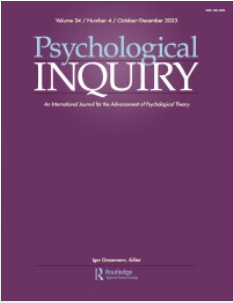自我平衡:自我增强作为一种生物适应
IF 4.1
2区 心理学
Q1 PSYCHOLOGY, MULTIDISCIPLINARY
引用次数: 0
摘要
一名荷兰少女开始接受激素治疗,以更充分地转变成她认为自己是什么样的女人。一位美国房地产大亨把自己的名字印在了他的赌场、酒店和摩天大楼上。一位西藏僧人在贫穷和孤立的情况下隐居在山里冥想。这三个人简直是天壤之别。然而,他们的行为可以很容易地理解为自我提升的动机,或者是建立一个满足个人、社会和文化价值观的自我形象的愿望(Sedikides & Strube, 1997)。自我提升涉及到大量的人类活动,从鲁莽驾驶(Ben-Ari, Florian, & Mikulincer, 1999)到意识形态极端主义(McGregor & Marigold, 2003)和怀旧幻想(Luo, Liu, Cai, Wildschut, & Sedikides, 2016)。自我提升进一步与心理健康和情感健康密切相关(Sedikides, Rudich, Gregg, Kumashiro, & Rusbult, 2004)。因此,对自我提升有更深刻的科学认识是很重要的。Sedikides(本期)通过提出一种新的自我提升理论模型进一步推进了这一目标。该模型的核心概念是,自我增强以情绪健康的形式促进心理稳态。更具体地说,体内平衡模型在自我增强和免疫系统之间进行了类比。正如身体免疫系统保护身体免受细菌或病毒等身体威胁一样,自我增强可能形成心理免疫系统,保护人们免受损失或批评等心理威胁。因此,内稳态模型将自我增强与情绪和情绪调节的动态联系起来。根据(社会)认知科学,自我提升的适应功能被认为是通过包含身份主题、自我观点和自传式记忆的联想网络来实现的。自我提升的内稳态模型(Sedikides,本期)是自我科学研究中具有里程碑意义的成就。该模型既有显著的优势,也有需要进一步发展的方面。在本文的其余部分中,我将进一步研究稳态模型。首先,我注意到将自我提升视为一种生物适应的一些理论上的好处。其次,我转向生理和心理稳态之间的关系。第三,我考虑了自我增强和免疫系统之间的类比,并建议消化系统可能提供一个有用的替代类比。最后,我将给出一些概括性的结论以及自我作为一种生物适应的观点。本文章由计算机程序翻译,如有差异,请以英文原文为准。
The Homeostatic Ego: Self-Enhancement as a Biological Adaptation
A Dutch teenager begins hormone treatment to more fully transition to the woman she feels she is. An American real estate mogul slaps his name on his casinos, hotels, and skyscrapers. A Tibetan monk retreats in the mountains to meditate in poverty and isolation. These three individuals could hardly be more different from another. Nevertheless, their behavior can be readily understood in terms of a selfenhancement motive, or the desire to forge a self-image that satisfies one’s personal, social and cultural values (Sedikides & Strube, 1997). Self-enhancement is implicated in a vast array of human activities, from reckless driving (Ben-Ari, Florian, & Mikulincer, 1999) to ideological extremism (McGregor & Marigold, 2003) and nostalgic reveries (Luo, Liu, Cai, Wildschut, & Sedikides, 2016). Self-enhancement further has close ties to psychological health and emotional wellbeing (Sedikides, Rudich, Gregg, Kumashiro, & Rusbult, 2004). Consequently, is important to achieve a deeper scientific understanding of self-enhancement. Sedikides (this issue) furthers this aim by proposing a new theoretical model of self-enhancement. Central to the model is the notion that self-enhancement promotes psychological homeostasis, in the form of emotional wellbeing. More specifically, the homeostatic model draws an analogy between self-enhancement and the immune system. Just as the physical immune system protects the body from physical threats like germs or viruses, self-enhancement may form a psychological immune system that protects the person against psychological threats like loss or criticism. The homeostatic model thus connects self-enhancement to the dynamics of emotions and emotion regulation. Drawing from (social-) cognitive science, the adaptive functions of self-enhancement are assumed to be served through associative networks that contain identity themes, self-views, and autobiographical memories. The homeostatic model of self-enhancement (Sedikides, this issue) is a landmark achievement in the scientific study of the self. The model has both notable strengths and aspects that are in need of further development. In the remainder of this article, I take a closer look at the homeostatic model. First, I note some of the theoretical benefits of conceiving of self-enhancement as a biological adaptation. Second, I turn to the relation between physiological and psychological homeostasis. Third, I consider the analogy between self-enhancement and the immune system, and suggest that the digestive system may provide a useful alternative analogy. I end with some general conclusions and outlook on the self as a biological adaptation.
求助全文
通过发布文献求助,成功后即可免费获取论文全文。
去求助
来源期刊

Psychological Inquiry
PSYCHOLOGY, MULTIDISCIPLINARY-
CiteScore
10.30
自引率
1.10%
发文量
31
期刊介绍:
Psychological Inquiry serves as an international journal dedicated to the advancement of psychological theory. Each edition features an extensive target article exploring a controversial or provocative topic, accompanied by peer commentaries and a response from the target author(s). Proposals for target articles must be submitted using the Target Article Proposal Form, and only approved proposals undergo peer review by at least three reviewers. Authors are invited to submit their full articles after the proposal has received approval from the Editor.
 求助内容:
求助内容: 应助结果提醒方式:
应助结果提醒方式:


